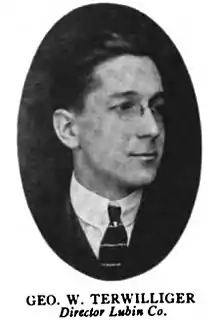George Terwilliger | |
|---|---|
 | |
| Born | George Walter Terwilliger February 27, 1882 New York City United States |
| Died | December 12, 1970 (aged 88) Hialeah, Florida United States |
| Occupations |
|
| Years active | 1902-1940s |
| Spouses | Hazel Belle Hubbard (m. 1909-1956; her death) |
| Children | George Terwilliger, Jr. (1924-1983) |
George Walter Terwilliger (February 27, 1882 – December 12, 1970) was an American film director, screenwriter, and journalist.[1][2] He worked in both the silent and sound eras, directing at least 76 productions between 1912 and 1936. He also wrote scores of screenplays for films released between 1910 and 1939. In 1912 alone, he was contracted by Lubin film studio to write one story a week for the company.
Early life and journalism
Born in Manhattan in 1882, George Terwilliger was the middle child of three children of James G. and Catherine A. (née Graves) Terwilliger. By 1900 his father, who worked as a clerk for the Central Railroad of New Jersey, had moved the family to the township of Linden in that state.[3] Young George received a relatively modest education, completing just two years of high school before quitting to find a job and a career.[lower-alpha 1] He was still living at his parents' home in New Jersey in 1900, but he soon returned to Manhattan, where he was hired by The New York Dramatic Mirror to work as an editor and writer. The Mirror, a weekly, provided some traditional news reports but focused on covering the world of theatre, reviewing stage acts, and Broadway plays. The newspaper in the first years of the twentieth century only allotted occasional coverage to the emerging industry of motion pictures, a relatively small patch of entertainment that The Mirror and many others in the New York media regarded then as a passing oddity, a "queer freak", that did not warrant considerable print.[4]
Around 1910, Terwilliger left The Mirror after working there for nine years to accept a job at The Morning Telegraph, another long-established New York weekly newspaper. The Telegraph contained general news and financial reports, although it specialized in theatrical coverage and horse-racing. Early on, it established too a department at the paper devoted specifically to covering motion pictures.[5] Terwilliger spent only a year with The Telegraph, but during that time he significantly expanded its film department's staff and operations. He also wrote reviews and film-related features under the pen name "Gordon Trent".[5] To supplement his limited income as an employee of newspapers published just once a week, Terwilliger wrote and edited stories, and sold "scenarios" to Biograph Studios in the Bronx such as The Lucky Toothache in 1910 and The Battle, directed by D. W. Griffith and released in 1911.[lower-alpha 2]
Selected filmography
Terwilliger served as both screenwriter and director on many film projects during his long career and as a cast member in a few productions. The following is just a partial list of his films.
- The Lucky Toothache (1910)
- The Clod (1913)
- The Daughters of Men (1914)
- The Gamblers (1914)
- The Nation's Peril (1915)
- The Ringtailed Rhinoceros (1915)
- The City of Failing Light (1916)
- The Last Shot (1916)
- Race Suicide (1916)
- The Lash of Destiny (1916)
- Her Good Name (1917)
- The Price Woman Pays (1919)
- Tom's Little Star (1919)
- Dollars and the Woman (1920)
- Slaves of Pride (1920)
- The Sporting Duchess (1920)
- The Fatal Hour (1920)
- The Misleading Lady (1920)
- Bride's Play (1922)
- What Fools Men Are (1922)
- Children of Dust (1923)
- Wife in Name Only (1923)
- Daughters Who Pay (1925)
- Married? (1925)
- The Big Show (1926)
- The Highbinders (1926)
- After the Fog (1929)
- Sentinel Light (Star) (1929), serial
- Ouanga (1936)
- The Devil's Daughter (1939)
- Poncomania (1940)
References
References
- ↑ Reid, John Howard (August 14, 2015). Silent Movies Plus! More Silent Films & Early Talkies on DVD. Lulu. ISBN 9781329414242. Retrieved June 15, 2019 – via Google Books.
- ↑ "TERWILLIGER, George", entry "Motion Picture Studio Directory" supplement, Motion Picture News (New York, N.Y.), October 21, 1916, p. 121. Internet Archive, San Francisco, California. Retrieved April 15, 2020.
- ↑ "Twelfth Census of the United States: 1900", Linden Township, Union County, New Jersey, June 8, 1900; digital copy of original enumeration page, Bureau of the Census, Washington, D.C.; archives of The Church of Jesus Christ of Latter-day Saints, Salt Lake City, Utah.
- ↑ Grau, Robert. The Theatre of Science: A Volume of Progress and Achievement in the Motion Picture Industry. New York, London and Paris: Broadway Publishing Company, 1914, p. 250.
- 1 2 Grau, p. 84.
Notes
- ↑ In both the federal census of 1930 and 1940, the highest education attained by George Terwilliger is recorded as "H2”, which is enumeration coding for completion of two years of high school or the 10th grade.
- ↑ Many of the staff screenwriters or "scenarists" for early film companies, such as George Terwilliger, Lawrence McCloskey, and William Henderson had previously worked as reporters or reviewers for newspapers and entertainment publications.
External links
 Media related to George Terwilliger at Wikimedia Commons
Media related to George Terwilliger at Wikimedia Commons- George Terwilliger at IMDb